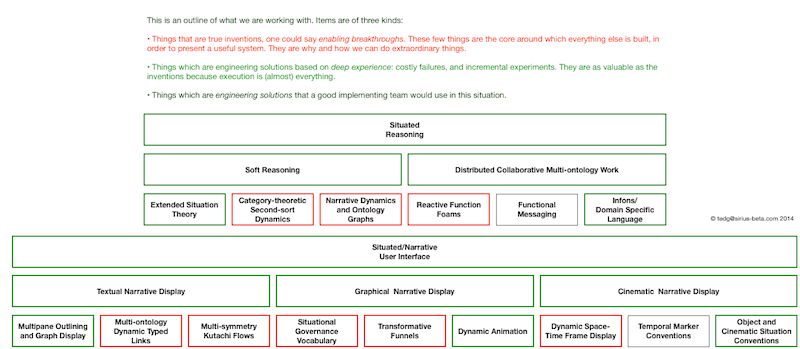The Space-Time scrubber does a lot and in static images looks cluttered.
So-called elevator pitches are problematic. I suppose they are necessary; people with resources get bombarded with all sorts of opportunities. Most of these are business ideas and most of those can be sufficiently evaluated in a few minutes.
But for us in our current situation, they're tough.
In my past lives, I'd be the one to blow someone off if they didn't have the time and skills to invest in understanding what we do. By definition, it is different or I wouldn't be doing it. That means rules of thumb don't apply. And you can't say something like "Oh, I get it. It's OkCupid for dogs."
We've decided to not talk about the technology, and instead talk about what it can do.
And then we've decided to not show the multi-world outliner, because to understand why it is cool, you have to understand what it is showing that is novel behind the scenes. Instead, if you were going to see one thing, you'll see the scrubber.
Now the problem is that until we get a real working setup, all the pictures look cluttered and complicated. It looks like we are serving a need that few people want and even then it will be too hard to work with, compared to say sports annotation software (with its scrubber).
Three Components
One is a frame preview, showing the current frame. The novelties here are that we can draw directly on it to highlight objects, environments and cinematic effects and have those serve as anchors in the film. We also have some novelty in how we can optionally place the preview image in the space-time scrubber to save space.
A second component is an ordinary scrubber with the only improvement that it has a shrunken image of the space-time scrubber on it.
In our simplest layout, the ordinary scrubber is at the bottom, the preview frame at the top and our space-time scrubber between. All of our advertised novelty is either explicit or implicit in this space-time scrubber.
The job of that scrubber is to allow a user to quickly move through a film and see content of the film, added drawings and movement on the film, and a variety of annotative anchor types on the film itself. These include dynamics as ephemeral as you want, or choreography as explicit as can be.
I'll put all the images and demos we make in the growing post for that purpose.
We do have a challenge in that so many different types of anchors can be displayed, and the film itself has a lot of information depth even without adding distractions. We intend to meet that challenge by very aggressive situating of the user. Some of this will be our system assembling the information in the way we know our user prefers, showing the annotations he/she is interested in. Part of it will be fluid control by the user over what is seen. There's a fine line between clutter and insight and we hope to allow each user to find his/her own balance.
In the meantime, to a prospective partner in an elevator, it will look like needless clutter.
